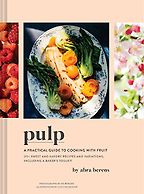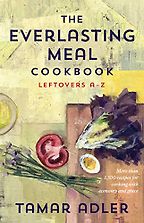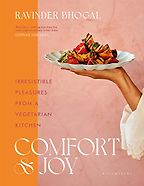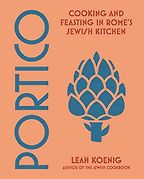Your selection of the five best cookbooks of 2023 seems quite diverse to me. Was there a particular theme that you feel ties them together or are they just the top five books produced this year?
That’s a good question. The theme is that these are all books that spoke particularly to various members of our staff. I think if there’s a common theme, it’s really about home cooks. We’re used to a lot of books from chefs. Those tend to get the most attention and glamor and publicity, but there is so much to learn from people who learn from their parents or their grandparents, make the most of what they have at home, and are being very practical and flexible and adaptable. I think that is a thread that goes through all of these books—at least four of the five.
Let’s go to the first title you want to highlight as one of the best cookbooks of 2023, Pulp, which is about how to use fruit imaginatively in cooking.
This is by Abra Berens, who is a chef I really like. She has written two other books: Ruffage, about vegetables; and Grist, about grains. This is the third in the series, and it focuses on fruit. What I love about her books is that they are cookbooks, and her recipes are very appealing and achievable, but they are also great reference books. These are the books that I keep at my desk when I want to learn about an ingredient.
She has tips on how to store fruit, how to prepare fruit, and how to preserve it. If you’re just looking for that kind of practical advice, this is a great source. If you want to learn about the people who make food or who produce it, she sheds a spotlight on that. She does profiles of producers. These are the unsung heroes who help make our food possible, and they often don’t get the attention they deserve. I appreciate that she talks about them.
She will let you pair different recipes together. She starts out the book with things to pair with fruit, like crackers and breads and batters and crusts, so that when you get to each individual fruit, you know what you can do with them as well. If you want to make a pie with this type of fruit, or you want to put this type of fruit over pudding—she helps you do that.
Also, and I think this is common throughout all these books, she’s a very strong writer. I love the way she writes. It feels like you’re standing with her at the farmers’ market and she’s telling you what to do. She says that blueberries are “the golden retriever of the fruit world,” that they’re just all-round pleasant company—which I think is great. You know exactly what she means when she says that.
Another thing I like is that she tucks variations into her recipes. If you read the introduction of the recipe, which is usually a few sentences, she will say: this also works with this fruit; if you don’t have this, use that.
I appreciate that she takes fruit seriously for the valuable commodity it is. It’s not just something you have to eat out of hand. People pigeonhole fruit. They think you just eat it on its own or it’s just for desserts, and she really shows that there’s so much more to it than that.
Excellent. Let’s move on to The Everlasting Meal Cookbook by Tamar Adler. This has won high praise from various quarters. Why is it one of the best cookbooks of 2023?
Yes. Similar to Pulp, it’s a great reference book. She has ideas for what to do with everything you have hanging around in your kitchen. She calls the book “a compendium of what to do with what you have.” That’s exactly what it is. You can page through and find ideas for every part of the potato or every variation on the potato—whether you have mash, whether you have this or that—and it makes you think twice before you toss the last bit of anything left in a jar.
Finish a jar of pickles? There’s the brine. What do you do with the brine? It’s easy enough to just pour it down the drain, right? The juice from a can of tomatoes is great for soups; it’s great for braises. Food waste is a big topic right now, and it can feel, on a large scale, very daunting. To know that there are things you can do in your own kitchen to tackle this yourself and make a meaningful impact in your own way is really empowering.
“There is so much to learn from people who learn from their parents or their grandparents, who make the most of what they have at home”
I think it’s easy to go down the rabbit hole and drive yourself crazy trying to use everything. I don’t think Adler wants you to do that; I think she wants you to take even just small steps to rethink leftovers. So much cuisine around the world is based on scraps or random odds and ends, and we’ve lost that way of thinking, in some ways.
We ran a recipe called Any Vegetable Minestra from this book. It is a very adaptable soup recipe: you use any liquid you have, any vegetables, any beans or starch. It’s all these disparate things that come together. You can flavor it however you want, and it’s just so smart. People need to be flexible with what they use, and I think this helps a lot.
Adler has a lyrical way of writing that is also very practical. It’s a very engaging read. This is one that my colleague Ann Maloney recommended. I read her copy of the book, and it’s full of bookmarks, which is a really good sign. I think this is one you’ll keep on the shelf and pull out all the time.
Next on your list of the best cookbooks of 2023 is Still We Rise, by Erika Council.
I chose this book. It is a baking book, so it’s right up my alley. It’s about biscuits, which I adore. For your readers in the UK, I just want to clarify that these are not what you would call biscuits, which are what we Americans call cookies; these are more akin to bread or rolls. They are a Southern specialty, although people eat them all over. They’re what you’d have with something else or on their own. They’re fluffy, they’re flaky.
I talked to Council for a piece I did on biscuits several years ago, and I was very happy to see that she released this book. It is possibly one of my favorite single-topic books. I was so excited when I saw this book, and it didn’t disappoint.
Even today, the contribution of Black cooks and Black women is seriously underappreciated and underrepresented. It’s never been given the same platform or praise as European fine cuisines. People don’t give it the respect it deserves. They think, oh, it’s just home cooking, whatever. It shouldn’t be that way. These are supremely talented cooks.
What I appreciate about Council’s book is that she also takes a historical perspective. She weaves in stories from her family, and older cookbooks that were published by Black women and groundbreaking at the time. In a small way, it’s starting to do what these types of authors haven’t been able to do in the past.
Again, I like that it’s a fairly narrow-topic cookbook. It lets you dive into a single type of food without feeling overwhelmed, and it makes you feel in awe of how many ways you can eat and make a biscuit. There are sweet biscuits; there are savory biscuits; there are ones that you fold almost like pastry, so you get layers; there are scoop biscuits, where you just stir and drop.
At the Post, I ran a recipe called Butter Swim Biscuits from this book. It was one of our most popular recipes of the year. It’s a dough that’s simply stirred together. You melt butter in a dish in a really hot oven, and then you pour the batter over and you bake them. You get these fluffy, tall, salty, buttery, crispy-edged biscuits. I think this is my new favorite way to make biscuits. They can feel intimidating sometimes, and this recipe is not intimidating.
She just has all different types of recipes and ways to make biscuits that I would never have thought of. She has options for people who are gluten-free or who prefer whole-wheat, so she’s trying to be really inclusive. I think it’s a fun book and I look forward to making all kinds of biscuits from it in the future.
Let’s move on to Comfort and Joy by Ravinder Bhogal. We’re going from biscuits to vegetables, right?
Yes, and they go well together. The Post’s Food and Dining editor, Joe Yonan, picked this book, and it’s completely engrossing. When he wrote about a recipe from this book, he said he immediately started bookmarking all the different recipes he wanted to make, which, again, is the sign of a great book. The recipe he did run was Cacio e Pepe Soup with Chickpeas and Kale, which also proved incredibly popular. It’s filling, comforting, and nourishing. It’s got cheese and butter, but also kale and chickpeas. Sometimes people think vegetarian food is very limiting, that it’s not filling, and that you’re going to still be hungry. This is just like a hug in a bowl. It’s the kind of book where you look through and you think, ‘I have never seen dishes like that before.’
Bhogal’s family background is Indian, but her grandfather had migrated to Kenya, so she spent the first seven years of her life in Kenya. She pulls inspiration from there, and she pulls inspiration from her Indian heritage, and now she’s based in the UK. Some of the things that I found really interesting are where she pulls together those different influences. She has pea kofta Scotch eggs, lemon and curry leaf crumpets. It’s so fun. This is the kind of stuff where you think, wow. It’s fusion not just for the sake of fusion. It’s really creative. She also pulls inspiration from other places. She has an Aegean dip that reminds her of Greece, and a hot corn and cheese dip that she had in New York, so it’s global and it’s fun and inspiring.
I love the way she writes with affection for her family, especially her grandfather and mother, and how they cooked for and nourished their families. I think she has a lot in common with Nigella Lawson, in terms of embracing the joy and sensuality of food, and that also comes across in the photos. They’re richly colored. They’re very enticing and fun. It’s a really exciting book and I’m looking forward to trying some more of these dishes, too.
And the final book on your list of the best cookbooks of 2023 is Portico, by Leah Koenig. This is about cooking in the Jewish Roman community.
My colleague Olga Massov recommended this book. It focuses on Jewish cooking in Rome. Jews in Rome have a very long history, dating back something like two thousand years. For about three hundred of those, they were limited to a ghetto, a very small area of Rome.
This gets at what I was talking about in terms of home cooking, and being smart with what you have, because they were limited to certain ingredients. There were a lot of things they couldn’t buy, they couldn’t get, they had to have the small types of fish, so these were ingenious recipes through which they made do with what they had.
The cover of the book has an artichoke on it, and fried artichokes are an iconic Roman Jewish dish. People go and get them and eat them on the streets now, but back then, it was because artichokes were one of the things they could actually acquire, in addition to lots of olive oil.
What Olga really liked about this book and what I also appreciated was that, in general, the recipes are short. They don’t require a lot of ingredients. They’re approachable, again, because these are homestyle recipes.
It’s also part travelogue. Koenig mentions in the introduction that she wrote a lot of it when she was in Covid-19 lockdown, and we weren’t traveling anywhere. You get that feeling of love and appreciation and yearning for a place that makes you want to hop on the next plane to Rome. When she finally was able to visit, she and her photographer went, and the photos are just stunning. They give you such a sense of place. You feel like you’re there, it’s about real people, and it definitely feels like a coffee table book that’s about travel and cooking.
One of my pet peeves is when there aren’t that many photos of recipes in cookbooks, because I want to know what the dishes look like. There are a lot of recipe photos in this book. Not every dish has one, but I don’t mind because there are so many great atmospheric photos of Rome that really make you feel like you’ve gone there or that you want to go.
Olga said she already has given this book to people as a gift for Hanukkah and they loved it. It’s a great merging of place and food, and you can tell that this is a place Koenig is passionate about. It wasn’t just that she thought, ‘I need to write another cookbook.’ She cares deeply about these recipes and history and people.
Five Books aims to keep its book recommendations and interviews up to date. If you are the interviewee and would like to update your choice of books (or even just what you say about them) please email us at [email protected]
Five Books interviews are expensive to produce. If you've enjoyed this interview, please support us by donating a small amount.










